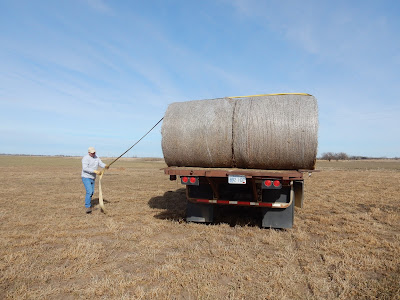 |
| Randy uses the loader tractor to place hay bales on the truck bed. |
hey·day
/ˈhāˌdā/
noun
 |
| After the bottom level is loaded, he ties down the front and back bales. |
But we've been in our "hay day" all this week.
The guys have loaded a semi with round bales of hay, then trucked it to Sebes Hay LLC near Larned every day this week. We feed the majority of the alfalfa we raise, though we do sell what's not needed for feeding to our cow-calf herd and the feeder calves that we retain during the winter months.
 |
| It's a good thing Randy isn't afraid of heights! |
It's important to get the bales firmly tied down to the truck bed for their 45-minute trip to the hay mill.
It takes longer to load the semi than it does to transport it. On average, it takes 11/2 to 2 hours to get the truck loaded and tied down.
To me, it resembles a Jenga game, strategically placing items in an effort to keep them upright. But we definitely don't want them to fall down.


He then deposits it on the trailer bed, placing the second layer of beds in the groove between the two bales below it.
 |
| This shows the net wrap on top of a bale - just a different perspective. |
I am glad that Randy does the loading. It takes a steady hand to exert enough pressure on the loader for the bale to stay in place but not push the one off on the other side!
Once all 34 bales are loaded, it takes teamwork to get the straps died down. This time, Ricky was on top of the trailer and threw the tie-down straps down to Randy.
Randy hooked the straps onto the trailer bed.
And they continued the process down the length of the trailer.
The guys also add safety flags. The flags are on wooden poles that get stuck in the bales.
(Note to self: Maybe some new flags would be a good Father's Day gift!)
Most of the time, Ricky has been hauling the load to Larned, so I haven't gone along to document that part of the process. Once there, he weighs the truck and then takes it to the unloading area. Most of the time, a Sebes Hay employee has off-loaded the hay. Then, Ricky weighs the empty truck before returning to the field for another load.
More Wide Loads ahead!
For more about harvesting hay on the County Line, please click this link.
Though I haven't been on a delivery run this year, click here to learn a little more about that process. (It's a different hay mill, but the processes would be similar.)













Such a relief to have had some good seasons. They are massive bales. I wonder if or how many times the loader didn't get it quite right and a bale has rolled off.
ReplyDeleteFewer times with Randy doing it than it would with me! He was trying to re-position one when I was out taking photos and he had to take it off and try again. He was trying to move it because I thought it was sticking out too far. He's probably glad I'm not there with my perfectionist tendencies all the time!
DeleteLOL
Delete